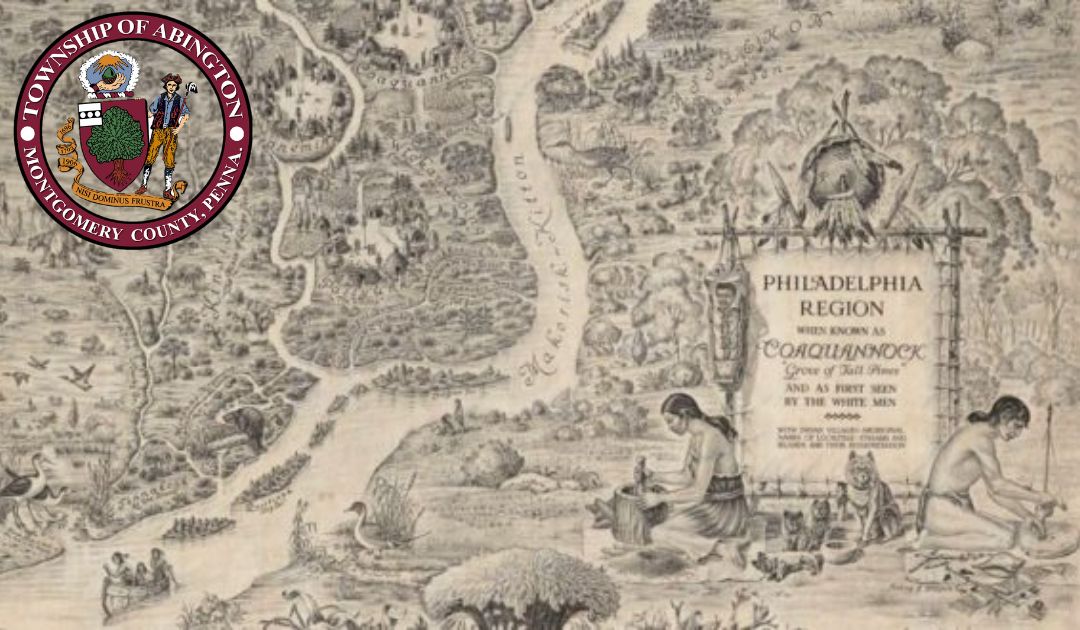In honor of Indigenous Peoples’ Day on Monday, October 9, local historian Mike Leibrandt has shared a number of sources which discuss the land that comprises Abington today as purchased from the native Lenni-Lenape by William Penn during the 1680s.
According to LenapeNation.com, the Lenape people are the original inhabitants of eastern Pennsylvania, southern New York, New Jersey, and northern Delaware (collectively referred to as the Lenapehokink, “land of the Lenape”). The Lenape were the first tribe to sign a treaty with the United States and the first tribe to have land set aside for them in New Jersey.
According to Helen L. Shaffer’s A Tour of Old Abington published in 1936,
Certain agreements with Indian tribes appear to have transferred the Abington area to the representatives of William Penn before the white man settled here. One suck deed dated June 23, 1863, the year after Penn came to America, conveyed to him the land between the ‘Pennypack and Neshaminy Creeks.’ This includes the eastern part of what became Abington Township. Signatures of eight Indians and four representatives of Pennsylvania were attached, together with a separate acknowledgment by ‘Tammanes,’ sometimes described as the Original Chief of Tammany. Payment was made, according to the deed, with wampum, guns, shoes, stockings, blankets, looking glasses and other goods; so much ‘as ye said William Penn shall be pleased to give unto us.’ Another deed (Indian) of 1687 gave Penn the land on both sides of the Schuylkill river, extending South to Chester Creek and north tot he Pennypack, including most of modern Abington and also considerable other territory already covered by other Indian deeds.
According to An Unusual History of Abington Presbyterian and Abington Community, in 1946, when York Road was widened, gravesites had to be moved. Records indicate 21 graves were to be moved, but when they were exhumed, 92 bodies were found, including those of Native Americans.
“It was somewhat of a community burying ground where people would come and bury their dead and no official record was kept,” An Unusual History of Abington Presbyterian and Abington Community said.
According to The Reporter, Abington Township’s Lorimer Park has a massive stone called Council Rock where the chiefs of local Native-American tribes met before the arrival of 16th and 17th century Europeans. They discussed the fate of the land eventually acquired by George Horace Lorimer, the early 1900s editor of The Saturday Evening Post.
Lorimer and Cyrus Curtis, The Post’s publisher, each had large estates on land once inhabited by the Lenape.
On May 4, 2021, Abington Quarterly Meeting endorsed a Minute of Reconciliation on behalf of the Lenape. An excerpt:
We acknowledge that the land our meetinghouse and school currently occupy was once home for the Lenni-Lenape. We also acknowledge that early members of our Meeting were members of the white settler population which benefited from the takeover of land and from the violence committed against Indigenous Peoples as a result of such actions as the Doctrine of Discovery, the Walking Purchase and Quaker Indian Boarding Schools. We acknowledge that some early members of our Meeting were enslavers and that the enslavement of Africans contributed to the accumulated wealth we have today. We apologize for these truths not being fully acknowledged by us sooner and because these actions have contributed to the physical and emotional trauma still being experienced today. We wish to atone for these past oppressions and injustices in the hope of bringing healing through retrospective justice to African Americans and Indigenous Peoples. To this end, we have set up the Bothwell Reparations Fund to which members and attenders may contribute. Also, we will continue with our deeper education to better understand and seek a renewed and ongoing right relationship.
For more on the Lenape Nation, you can click here. For an illustrated map of the Philadelphia Region when it was known as Coaquannock, “Grove of Tall Pines,” you can click here.
For all the latest news, follow us on Facebook or sign up for Glenside Local’s “Daily Buzz” newsletter here.
Image courtesy of the Historical Society of Pennsylvania

